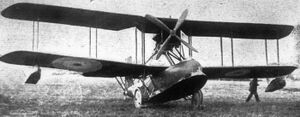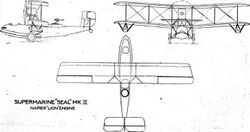Engineering:Supermarine Seal
| Seal | |
|---|---|

| |
| Role | Reconnaissance flying boat |
| Manufacturer | Supermarine |
| Designer | R. J. Mitchell |
| First flight | May 1921 |
The Supermarine Seal was a United Kingdom amphibian biplane flying boat developed by the Supermarine company. The Seal was further developed into the Supermarine Seagull.
The Seal was designed to operate from either shore stations or warships, including the ability to land and take off from aircraft carriers.
Design and development
The Seal was a two-bay biplane with the lower wing mounted on top of the fuselage and the engine mounted below the centre-section of the upper wing. The primary structure of the fuselage was roughly circular in cross-section and was built of planking over a framework of formers and stringers covered with fabric, with the planing surfaces built as separate structures, divided into watertight compartments.[1]
Specifications (Seal II)
Data from Supermarine Aircraft since 1914[2]
General characteristics
- Crew: 3
- Length: 32 ft 10 in (10.01 m)
- Wingspan: 46 ft 0 in (14.02 m)
- Height: 14 ft 10 in (4.52 m)
- Wing area: 620 sq ft (58 m2)
- Empty weight: 4,100 lb (1,860 kg)
- Gross weight: 5,600 lb (2,540 kg)
- Powerplant: 1 × Napier Lion W-12 water-cooled piston engine, 450 hp (340 kW)
- Propellers: 4-bladed wooden fixed-pitch pusher propeller
Performance
- Maximum speed: 112 mph (180 km/h, 97 kn)
- Endurance: 4 hours
- Time to altitude: 10,000 ft (3,048 m) in 17 minutes
See also
Related development
Related lists
- Seaplanes and flying boats
References
Sources
- Andrews, C.F.; Morgan, E.B. (1987). Supermarine Aircraft since 1914. London: Putnam. ISBN 978-0-85177-800-6.


